List of Hanfu headwear
Chinese headwear have a long history. According to some scholars, China used to be called "the Kingdom of Headwear" by people due to its variety of colourful and artistic style of hair ornament.[1] Chinese women, in particular, like to use flowers (either natural or artificial) as hair decorations for centuries.
Types of Headwear for males[]
| Name | Definition | Suitable age | Match | Period | Images | |||
|---|---|---|---|---|---|---|---|---|
| Mian Guan (冕冠) | Shi er liu mian (十二旒冕) | Twelve-tasselled Crown.
Initially all Mian Guan were worn by emperors, later emperors only wore this type.[2] |
Adult | Zhou – Ming | 
|
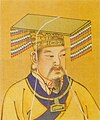
|

| |
| Jiuliu mian (九旒冕) | Nine-tasselled Crown. | Adult | Zhou – Han | 
|

|
|||
| Others | Baliu mian (八旒冕): Eight-tasselled Crown. Worn by princes and dukes.[5]Qiliu mian (七旒冕): Seven-tasselled Crown. Worn by ministers.[6]
Wuiu mian (五旒冕): Five-tasselled Crown. Worn by viscounts and barons. | |||||||
| Pibian (皮弁) | Leather Crown. Embedded with jades. Worn by all nobles.[7] | Adult | Zhou – Ming | 
|

|

| ||
| Liang Guan (梁冠) | Tongtian Guan (通天冠)/
Gaoshan Guan (高山冠) |
Sky-reaching Crown/High Mountain Crown. Worn by emperors in special occasions.[8][9][10] | Adult | tongtianguanfu (通天冠服) | Qin – Ming | 
|

|
|
| Yuanyou Guan (远游冠) | Travel Crown. Worn by emperors and princes. Similar to Tongtian Guan.[11] Also worn by dukes in Han dynasty.[10] | Adult | Qin – Ming | 
|

|

| ||
| Diaochan Guan (貂蟬冠) | Mink's Tail and Cicada's Wing Crown. Worn by emperor's servants and government officials.[12][13] | Adult | Qin – Ming | 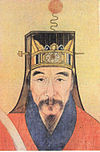
|

|
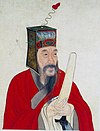
| ||
| Jinxian Guan (進賢冠) | Recommending Crown. First worn by confucian scholars, later worn by government officials.[14][10] | Adult | Zhou – Ming | 
|

|

|
||
| Zhongjing Guan (忠靖冠) | Loyal and stable crown. Worn by retired officials.[15][16] | Adult | Ming | 
|

|

| ||
| Shufa Guan (束发冠) | Hair-gathering Crown. A small cap to gather hair inside, fixed with long hairpin. Daily wear of all male. Mini size, sometimes in shapes of Liangguan.[17] | Adult | Five Dynasties - Ming | 
|

|

| ||
| Chang Guan (长冠) | Long Crown. Designed and First worn by Emperor Gaozu of Han. Later worn by Han dynasty's officials.[18] | Adult | Han | |||||
| Pingshanze
(平上幘) |
A cylindrical cap; it has a higher back and lower front. Used commonly by military personnel, while another variant called "Jieze"(介帻) is used by civil servants and commoners.[19][20] | Han-Jin |
|

|

| |||
| Longguan (籠冠) | "Basket hat". Developed from the Wubian("武弁")-hat, alternatively also known as Wuguan "武冠", worn by military officials. [21] [22] Helmets or tall peaked caps; it extends down over the ears and neck.[20] It is semi-transparent.[22] | Jin | 
|

|

| |||
| Lianhua Guan (莲花冠) | Lotus Crown. First worn by highest rank Taoist Maste, later also worn by the nobility. | Adult | Tang - Song | 
|

|

| ||
| Putou (襆頭) | Chuijiao Putou (垂腳襆頭) | Head cover/Head wrap. An early form of informal headwear dates back as early as Jin dynasty that later developed into several variations for wear in different occasions. | Adult | Tang – Ming | 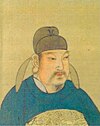
|
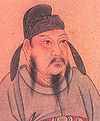
|

| |
| Zhanjiao Putou (展角幞頭) | Spread-horn head cover. Designed by Emperor Taizu. Elongated horns on both sides can keep the distance between officials so they couldn't whisper to each other during court assemblies. | Adult | Changfu (Tang), Gongfu (Song-Ming) | Tang – Ming | 
|

|

| |
| Zhanchi Putou (展翅幞頭) | Spread-wing head cover. Commonly as Wushamao (乌纱帽), Black-cloth hat. Standard headwear of officials during the Ming dynasty. The term "Wushamao" is still frequently used as Chinese slang referring to government positions. | Adult | Ming | 
|

|

| ||
| Yishan Guan (翼善冠) | Philanthropy Crown, with wings folded upwards. Worn by emperors and princes of the Ming dynasty, as well as kings of many China's tributaries. Sometimes decorated with jewels and dragons. | Adult | Tang – Ming | 
|

|

| ||
| Tang jin (唐巾) | Adult | Ming | 
|
|||||
| Gaowu mao (高屋帽) | Baisha mao (白紗帽) | Also known as white gauze hat. It was worn by the sovereigns of Liu-Song and Southern Qi, it was later inherited by the Sui dynasty.[23] | Adult | White gauze hat. | Northern and Southern dynasties – Tang | 
|

|
|
| Wusha Gaowu mao (烏紗高屋帽) | High reach black gauze hat. | Adult | Northern and Southern dynasties – Song | 
|
||||
| Zhulu mao (逐鹿帽) | Adult | Northern and Southern dynasties | ||||||
| Liuheyitong mao (六合一統帽) | 'Six-part' United hat. Name originate from Ming dynasty's founder Hongwu Emperor uniting China in six direction, earth to sky, east to west, north to south. The hat would later develop into the "Guapi Mao"(瓜皮帽) skullcap in the Qing dynasty.[24] | Adult | Ming | 
|

|

| ||
| Zhuangzi jin (莊子巾) | Adult | Zhou – Han | 
|

|
||||
| Fu jin (幅巾) | Adult | Han – Ming | 
|

|

| |||
| Cheng zi guan (程子冠) | Adult | Five Dynasties and Ten Kingdoms - Song | 
|

|
||||
| Dongpo jin (東坡巾) | Adult | Song – Ming | 
|

|

| |||
| Zhouzi jin (周子巾) | Adult | Song – Ming | 
|
|||||
| Sifang pingding jin (四方平定巾) | Adult | Ming | 
|
|||||
| Wangjin (網巾) | Adult | Ming | 
|

|
||||
| Hutou mao (虎头帽) | Tiger head hat. | Children | Song - Modern time | 
|

|

| ||
| Zhuangyuan mao (状元帽) | Champion hat. | Children | Song - Modern time | 
|

|

| ||
| Chixiao mao (鴟鴞帽) | Owl hat. | Children | Song - Modern time | 
|

|
|||
| Xianggong mao (相公帽) | Husband hat. | Children | Song - Modern time | 
|

|

| ||
| Wuguan (武冠) | Military cap. The front of was ornamented with a dang (璫; a gold ornament in the form of animals, such as dragons, cicada, and people). In the Han dynasty military caps were also decorated with long-tailed pheasant's tail feathers to denominate martial status.[25][26][27][20] | Adult | Zhou-Jin | 
|

|

| ||
Types of headwear for females[]
| Name | Definition | Description | Suitable age | Match | Period | Images | |||
|---|---|---|---|---|---|---|---|---|---|
| Ji (笄) | Hairpins. | Single-pronged hairpin.[28] They were often inscribed with auspicious patterns.[29] | Adult | Neolithic – Qin | 
|

|

| ||
| Zan(簪) | Ornamental hairpins.[30] | Long, single-pronged hairpin after Qin dynasty.Small ornaments (e.g. flowers) could also be affixed on it[28][31] | Adult | Han – Qing | 
|

|
|||
| Chai(钗) | U-shaped or V-shaped hairpin.[31] | Two-pronged hairpin.[28][31] | Adult | Han – Qing | 
|

|
|||
| Three-legged hairpin.[31] | Typically made of bronze.[31] | Jin | |||||||
| Yanbin (掩鬓) | The hairpin covering sideburns. | Adult | Ming – Qing | 
|

|
||||
| Buyao (步摇); "step-sway" or "dangling hairpin" or literally "dangling with one's walking steps".[32][33][28][34] | Buyao Zan (步摇簪) | Buyao hairpin. | Single-pronged hairpin with dangling decorations. | Adult | Han – Qing | 
|
|||
| Buyao Shu
(步摇树) |
Buyao Tree. | Tree-shaped dangling decoration centered at front of hair. | Adult | Han – Ming | 
|

|

| ||
| Buyao Guan
(步摇冠) |
Buyao Crown. | Crown consisted of dangling decorations. | Adult | Han – Ming | 
|
||||
| Zan hua (簪花) | Flower hairpin. | Could be fresh flower, silk flower, and flowers made with other materials. Man could also wear. | Adult | Tang - Qing | 
|

|

| ||
| Huasheng (華勝) | Round flower hairpin centered front of hair. | Adult | Han – Song | 
|

|
||||
| Di Guan (翟冠) | Adult | Song - Ming | 
|

|

| ||||
| Hua Guan (花冠) | Flower Crown.[35] | Adult | Han – Song | 
|
|||||
| Tang gongzhu touguan
(唐公主头冠) |
Tang Princess's Crown | Adult | Tang | 
|
|||||
| Feng Guan (鳳冠) | Huashu Guan
(花树冠) |
Flower Tree Crown. | Adult | Tang | |||||
| Feicui Fengguan (翡翠凤冠) | Jade Phoenix Crown. | Adult | Tang | 
|
|||||
| Long Feng Huacha Guan (龙凤花钗冠) | Dragon Phoenix Hairpin Crown. | Adult | Song-Ming | 
|

|

| |||
| Yanju Guan
(燕居冠) |
Adult | Ming | 
|

|

| ||||
| Mo E (抹额) | Piece of garment covering forehead. | Adult | Tang-Qing | 
|
|||||
| Lianhua mao (莲花帽) | Lotus hat. | Children | Song - Modern time | 
|
|||||
| Shubi (梳篦)[36] or zhi | Shu (梳) | Comb.[37] | Ancient - Modern | 
|

|

| |||
| Bi (篦) | Fine-toothed comb.[37] | Spring and Autumn period - Modern | 
|
||||||
| Mili (羃䍦) | A hat with a long veil which covered the face and body | Tang dynasty - Tang dynasty | 
|
||||||
| Weimao (帷帽) | A hat with a hanging veil which covers the face.[38] | Tang dynasty | 
|
||||||
| Mianyi (面衣) or gaitou (蓋頭) | Veils or "facial clothes". | A purple gauze which hangs on a hat from the front to the back with 4 ribbons of different colours hanging down from on the shoulders. Originated from the Tang dynasty's weimao (帷帽).[38] | Adult | Song dynasty - Unknown | 
|

|
|||
| (胡帽) | "Barbarian hat". | A hat without the veil. | Tang dynasty | ||||||
| Liangmao (涼帽) | "Cool hat". | A hat worn by the Hakka women, a Han ethnic subgroup when working in the fields. It is made of a flat disc of woven bamboo with a hole in the centre and has a black (or blue) cotton fringe.[39][40] | Unknown - Present | 
|
|||||
See also[]
- Hanfu
- List of Hanfu
- Chinese hairpin
- Shubi - Chinese comb
- Tian-tsui
References[]
- ^ Han, Myun-Sook; Im, Sung-Kyung (2005). "A Study on the Artificial Flowers as a Hair Ornament in China" (PDF). Proceedings of the Costume Culture Conference (복식문화학회:학술대회논문집). The Costume Culture Association: 67–69. Archived from the original on 2021.
- ^ "32". Rites of Zhou Annotation.
云“缫不言皆,有不皆”者,谓王之五冕,缫则有十二,有九,有七,有五,有三,其玉旒皆十二,故缫不言皆。有不皆者,则九旒已下是也。玉言皆,则五冕旒皆十二玉也。
- ^ "32". Rites of Zhou.
诸侯之缫斿九就...每缫九成,则九旒也。
- ^ "25". Book of Jin.
皇太子...其侍祀则平冕九旒
- ^ "25". Book of Jin.
王公八旒。
- ^ "25". Book of Jin.
卿七旒。
- ^ "4". Rites of Zhou.
王之皮弁,会五采玉綦,象邸玉笄...诸侯及孤卿大夫之冕、韦弁、皮弁、弁绖...
- ^ "25". Book of Jin.
天子郊祀天地明堂宗庙,元会临轩,黑介帻,通天冠,平冕...通天冠,本秦制。
- ^ "120". Book of Later Han.
高山冠,一曰侧注。制如通天,顶不邪却,直竖,无山述展筒,中外官、谒者、仆射所服。太傅胡广说曰:“高山冠,盖齐王冠也。秦灭齐,以其君冠赐近臣谒者服之。”
- ^ a b c Feng, Ge; Du, Zhengming (2015). Traditional Chinese rites and rituals. Newcastle upon Tyne: Cambridge Scholars Publishing. ISBN 9781443887830. Retrieved 4 February 2021.
- ^ "25". Book of Jin.
远游冠,傅玄云秦冠也。似通天而前无山述,有展筒横于冠前。皇太子及王者后、帝之兄弟、帝之子封郡王者服之。诸王加官者自服其官之冠服,惟太子及王者后常冠焉。太子则以翠羽为緌,缀以白珠,其馀但青丝而已。
- ^ "48". Yiwen Leiju.
秦始皇复古冠貂蝉,汉因而不改。此内官侍帷幄,受顾问,拾遗于左右,出则负玺以从,秩二千石。
- ^ "36". Book of Han.
今王氏一姓乘朱轮华毂者二十三人,青紫貂蝉充盈幄内,鱼鳞左右。
- ^ "120". Book of Later Han.
进贤冠,古缁布冠也,文儒者之服也。前高七寸,后高三寸,长八寸。公侯三梁,中二千石以下至博士两梁,自博士以下至小史私学弟子,皆一梁。宗室刘氏亦两梁冠,示加服也。
- ^ "明忠靖冠".
- ^ "67". History of Ming.
帝因复制《忠静冠服图》颁礼部,敕谕之曰:“祖宗稽古定制,品官朝祭之服,各有等差。第常人之情,多谨于明显,怠于幽独。古圣王慎之,制玄端以为燕居之服。比来衣服诡异,上下无辨,民志何由定。朕因酌古玄端之制,更名‘忠静’,庶几乎进思尽忠,退思补过焉。朕已著为图说,如式制造。在京许七品以上官及八品以上翰林院、国子监、行人司,在外许方面官及各府堂官、州县正堂、儒学教官服之。武官止都督以上。其馀不许滥服。”礼部以图说颁布天下,如敕奉行。按忠静冠仿古玄冠,冠匡如制,以乌纱冒之,两山俱列于后。冠顶仍方中微起,三梁各压以金线,边以金缘之。四品以下,去金,缘以浅色丝线。
- ^ Nanjing Museum General Office. "Info of 'Amber Shufa Guan'".
束发冠是古代男子用来约发的小冠,属闲居之服。出现在五代,宋代以后使用者渐多,至明代尤为盛行。束发冠通常以玉石、木材或金属丝制成,此外也有牛角、龟壳、椰壳等质地的。外形变化较多,常见者作梁冠状,有的还缀有各种珠宝,使用时扣覆在发髻之上,以簪子固定。
- ^ "120". Book of Later Han.
长冠,一曰斋冠,高七寸,广三寸,促漆纚为之,制如板,以竹为里。初,高祖微时,以竹皮为之,谓之刘氏冠,楚冠制也。民谓之鹊尾冠,非也。祀宗庙诸祀则冠之。皆服袀玄,绛缘领袖为中衣,绛裤袜,示其赤心奉神也。五郊,衣帻裤袜各如其色。此冠高祖所造,故以为祭服,尊敬之至也。
- ^ "26". 晋书.
“介帻服文吏,平上帻服武官也”
- ^ a b c Laursen, Sarah (2019). "10 Dressing the Dead in Jin China". The art and archaeology of bodily adornment : studies from Central and East Asian mortuary contexts. Sheri Lullo, Leslie V. Wallace. Abingdon, Oxon: Routledge. pp. 176–195. ISBN 978-1-351-26832-5. OCLC 1090702934.
- ^ "11". Book of Sui.
武冠,一名武弁,一名大冠,一名繁冠,一名建冠,今人名曰籠冠,即古惠文冠也。天子元服,亦先加大冠。今左右侍臣及諸將軍武官通服之。侍中常侍,則加金璫附蟬焉,插以貂尾,黃金為飾云。
- ^ a b Dien, Albert E. (2007). Six dynasties civilization. New Haven, Conn.: Yale University Press. p. 313. ISBN 978-0-300-07404-8. OCLC 72868060.
- ^ Cunrui, Victor Xiong (2006). Emperor Yang of the Sui Dynasty : His Life, Times, and Legacy. State University of New York Press. pp. 132–134. ISBN 978-0-7914-8268-1. OCLC 1042816832.
- ^ 崔, 荣荣; 牛, 犁 (2017). "从瓜皮帽的流行演变看社会变迁". 江西社会科学 (8): 133–137.
- ^ "120". Book of Later Han.
“武冠,一曰武弁大冠,诸武官冠之。侍中、常侍加黄金珰,附蝉为文,貂尾为饰,谓之赴惠文冠。”
- ^ "120". Book of Later Han.
“武冠,俗谓之大冠,环缨无蕤,以青系为绲,加双鹖尾,竖左右,为鹖冠云”
- ^ 禽经.
“鹖,毅鸟也,毅不知死。状类鸡,首有冠,性敢于斗,死犹不置,是不知死也。《左传》:鹖冠,武土戴之,象其勇也。 ”
- ^ a b c d Yuan, Xiaowei (2017). "Traditional Chinese Jewelry Art: Loss, Rediscovery and Reconstruction Take Headwear as an Example". Proceedings of the 2nd International Conference on Contemporary Education, Social Sciences and Humanities (ICCESSH 2017). Paris, France: Atlantis Press. doi:10.2991/iccessh-17.2017.135. ISBN 978-94-6252-351-7.
- ^ Zang, Yingchun; 臧迎春. (2003). Zhongguo chuan tong fu shi. 李竹润., 王德华., 顾映晨. (Di 1 ban ed.). Beijing: Wu zhou chuan bo chu ban she. ISBN 7-5085-0279-5. OCLC 55895164. Archived from the original on 2003.
- ^ Jin, Cao (2018). Southwest China in a Regional and Global Perspective (c.1600-1911) Metals, Transport, Trade and Society. Brill. p. 141. ISBN 9789004353718.
- ^ a b c d e Laursen, Sarah (2019). "10 Dressing the Dead in Jin China". The art and archaeology of bodily adornment : studies from Central and East Asian mortuary contexts. Sheri Lullo, Leslie V. Wallace. Abingdon, Oxon: Routledge. pp. 176–195. ISBN 978-1-351-26832-5. OCLC 1090702934.
- ^ Zhu, Ruixi; 朱瑞熙 (2016). A social history of middle-period China : the Song, Liao, Western Xia and Jin dynasties. Bangwei Zhang, Fusheng Liu, Chongbang Cai, Zengyu Wang, Peter Ditmanson, Bang Qian Zhu (Updated ed.). Cambridge, United Kingdom: Cambridge University Press. p. 30. ISBN 978-1-107-16786-5. OCLC 953576345.
- ^ Müller, Shing (2019). The Cambridge history of China. 2. Denis Crispin Twitchett, John King Fairbank. Cambridge [England]: Cambridge University Press. pp. 384–417. ISBN 978-0-521-24327-8. OCLC 2424772.
- ^ Sarah, Laursen (2011-01-01). Leaves that sway: Gold Xianbei cap ornaments from northeast China. ScholarlyCommons. OCLC 857244457.
- ^ Zhu, Ruixi; 朱瑞熙 (2016). A social history of middle-period China : the Song, Liao, Western Xia and Jin dynasties. Bangwei Zhang, Fusheng Liu, Chongbang Cai, Zengyu Wang, Peter Ditmanson, Bang Qian Zhu (Updated ed.). Cambridge, United Kingdom: Cambridge University Press. pp. 645–648. ISBN 978-1-107-16786-5. OCLC 953576345.
- ^ Stent, George Carter (1871). A Chinese and English vocabulary in the Pekinese dialect by George Carter Stent. Customs Press. p. 423.
- ^ a b "Chinese Shubi". en.chinaculture.org. Retrieved 2021-03-19.
- ^ a b Xu, Man (2016). Crossing the Gate: Everyday Lives of Women in Song Fujian (960–1279). SUNY Press. p. 70-72. ISBN 978-1438463223.
- ^ "Hong Kong Museum of History". www.lcsd.gov.hk. Retrieved 2021-04-02.
- ^ Garrett, Valery (2012). Chinese Dress : From the Qing Dynasty to the Present. New York: Tuttle Pub. p. 327. ISBN 978-1-4629-0694-9. OCLC 794664023.
Categories:
- Hanfu
- Chinese headgear
